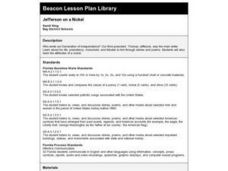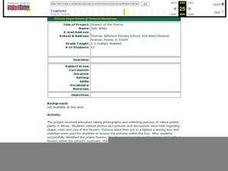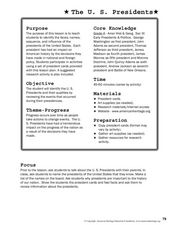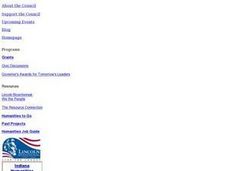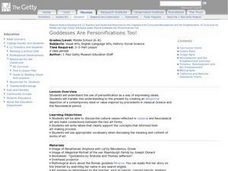Curated OER
Jefferson on a Nickel
Students study our third president, Thomas Jefferson through stories and poems. They investigate the attributes of a nickel.
Curated OER
A President's Home and the President's House
Young scholars identify specific examples demonstrating how present-day White House reflects duties, powers, and privileges of the office of President, and
compare and contrast Thomas Jefferson's Monticello with the White House.
Curated OER
From the White House of Yesterday to the White House of Today: A President's Home and the President's House
Stduents look closely at what one President did at his home in contrast to what Presidents have done in the White House. They take a virtual tour of the White House and Monticello.
Curated OER
VS.6b
Sixth graders explore, analyze and identify the ideas of George Mason and Thomas Jefferson as expressed in the Virginia Declaration of Rights and the Virginia Statue for Religious Freedom. They list and declare the responses stated in...
Curated OER
VS.6a
Sixth graders explore, discuss and explain why George Washington is called the "Father of our Country" and James Madison is called the "Father of the Constitution." They view and create a graphic organizer after discussing a variety of...
Curated OER
Seeing Is Believing
Learners research and describe the stories of Thomas Jefferson, Meriwether Lewis and William Clark. They analyze historical sources from different points of view and present an analysis of two historical contexts.
Curated OER
Thomas Jefferson
Fourth graders recall the names of the first two presidents of the United States and identify the man who became the third. They compose an epitaph for Thomas Jefferson.
Curated OER
Rollin' Down the River
Students examine the contributions of Lewis and Clark. In this Louisiana Purchase lesson, students research Internet and print sources regarding the Lewis and Clark expedition.
Curated OER
A President's Home and the President's House
Learners examine the differences between the White House and Monticello. In small groups, they complete a virtual tour, complete a graphic organizer, take notes during the tour, and identify activities taking place at the White House.
North Carolina Consortium for Middle East Studies
Missing Pieces of the Puzzle: African Americans in Revolutionary Times
What's missing from most studies of the American Revolutionary War is information about the role African Americans played in the conflict. To correct this oversight, middle schoolers research groups like the Black Loyalists and ...
Curated OER
Understanding James Madison The Father of the Constitution
Students research James Madison and create a table of his strengths and weaknesses. For this James Madison lesson, students read Jean Fritz's, The Great Little Madison, while developing their research skills, vocabulary strategies, and...
Curated OER
First Grade American Civilization: February
First graders examine and discuss the Boston Tea Party, Paul Revere, Redcoats, Thomas Jefferson and the Declaration of Independence. They conduct an experiment done by Benjamin Franklin, solve a word puzzle written in code by Ben...
Curated OER
Flowera of the Prairie
Students with severe disabilities view pictures of flowers in a scanning box and identify them. Outside, they locate flowers on the school's property, label and care for them. Students use flower pictures to aid identification.
Curated OER
Patriotic Slaves
Eleventh graders listen to a song and read the lyrics and discuss what patriotism means to them. After viewing pictures of important patriots throughout history, they describe their contribution to society. They write in their journals...
Curated OER
The U.S. Presidents
Students identify the Presidents of the U.S. by their physical characteristics and their impact on America. In this Presidents lesson plan, students read about each President, look at their pictures, and identify each of them based on...
Curated OER
New $1 Coins Honor U.S. Presidents
Elementary schoolers examine money, then read a news article about new coins being produced by the U.S. Mint. The teacher introduces the article with samples of American money and a vocabulary activity, then students read the news piece...
Curated OER
George Washington
Students explore the life and times of George Washington. They research for information on George Washington. Students use KidPix to create a pictorial and written report on George Washington and present their movie to the class.
Curated OER
Presidential Trading Cards
Young scholars research the Internet to collect data about the US Presidents. They use the data that they collect along with available technology to produce trading cards and brochures using keyboarding skills, text boxes, acquiring...
Curated OER
Goddesses Are Personifications Too!
Students explore the use of personification as a way of expressing ideals. They transfer this understanding to the present by creating an allegorical depiction of a contemporary ideal or value inspired by precedents in the...
Curated OER
Native Americans 1700s-1800s
Eighth graders investigate and explain major Native American groups, events, individuals and conflicts from the 1700s through the 1800s in the early American colonies and the United States.
Curated OER
Goddesses are Personifications Too!
Students analyze the use of personification in classical Greek art and the Neoclassical period. In this Neoclassical art lesson, students discuss the cultural values reflected in classical and Neoclassical....
Curated OER
Goddesses Are Personifications Too!
Students discover the use of personification as a way of expressing ideals. In this Language Arts instructional activity, students create an allegorical depiction of a contemporary ideal. Students write labels that clearly...
Curated OER
Slavery in Virginia
Fourth graders assess primary sources to analyze the effects plantation life and slavery had on Colonial Virginia. They study the issues of slavery, rural life, movements, colonization and revolution. Each student makes predictions,...
Curated OER
Amazing Americans
First graders research amazing Americans during the first 100 years of American history. After a lecture/demo, 1st graders use a worksheet imbedded in this plan to write 2-4 sentences about 4 of the Americans presented in class.


